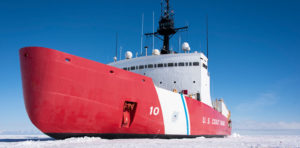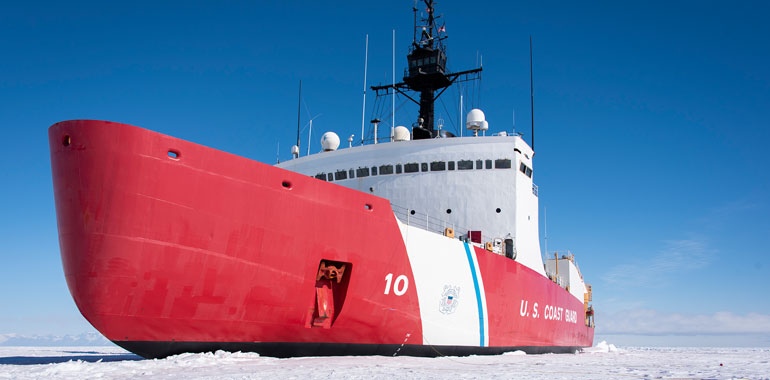
The only surviving heavy icebreaker in the U.S. Coast Guard fleet, the 44-year-old Polar Star (WAGB 10), has a new winter mission after the COVID-19 pandemic caused the cutter’s annual resupply excursion to McMurdo Station in Antarctica to be canceled. Instead, Polar Star sailed to the Arctic in early December from Seattle, where it is home-ported, marking the icebreaker’s first trip to the northern polar region in 22 years.
Polar Star usually transits to Mare Island Dry Dock in Vallejo, Calif., after Operation Deep Freeze each year for maintenance and repairs before sailing back to Seattle. The Coast Guard reported that last winter’s Antarctic mission was a success, with no major malfunctions or issues compared to some previous voyages south. The 399-foot icebreaker is showing its age, though — it is close to 15 years past its intended 30-year service date — and the Coast Guard noted that spare parts are getting much harder to find since production of certain items has long since ceased. The icebreaker’s exterior was repainted in 2017.
Polar Star’s sister ship, Polar Sea (WAGB 11), sits idle in Seattle due to an engine casualty and has been used for spare parts since 2011. The Coast Guard deemed repairs of Polar Sea’s engines as too costly, so Polar Star sails on as the nation’s only heavy icebreaker until the commissioning of the first polar security cutter (PSC) in 2024. The PSCs are much improved in design, with the capability of steaming through ice 6 to 8 feet thick. Polar Star is tentatively scheduled to serve until 2027.
This northward voyage for Polar Star resulted from problems on Healy (WAGB 20), a 21-year-old medium icebreaker that suffered an engine room fire and starboard drive breakdown during its Arctic voyage in August 2020. Healy currently resides at Mare Island, undergoing an extensive and expensive repair that requires cutting into the side of its thick hull to remove the damaged engine. A replacement engine has been shipped from the East Coast through the Panama Canal and up the West Coast to Mare Island. As a result of Healy’s engine room fire, the Coast Guard only has one operational polar icebreaker.
With the Northwest Passage opening up due to the melting polar ice cap, commercial shipping and the hunt for resources by Russia, China and the surrounding Arctic nations require Coast Guard vigilance and patrolling of the Arctic Circle. The service has the medium-endurance cutter Alex Haley and several Sentinel-class fast response cutters in Alaska, but only Polar Star can cut through heavy ice on this specialized mission north.
“Polar Star will deploy into the Arctic this winter in support of the Coast Guard’s Arctic strategy,” Lt. Cmdr. Stephen Brickey told Professional Mariner. “The cutter will depart with an intended route that will be changed as needed. (It) will patrol along the U.S.-Russia maritime boundary line, strengthen international and intergovernmental partnerships, and project U.S. presence and sovereignty into the Arctic.”
Potential duties for Polar Star could include visit, board, search and seizure (VBSS), fisheries enforcement and inspections, escorting and inspection of commercial shipping, icebreaking and freeing ice-trapped vessels, and matters related to homeland security and national defense. Polar Star isn’t armed for its Antarctic excursions, but for the Arctic trip it sailed with two .50-caliber heavy machine guns and an “assortment of sidearms,” the Coast Guard said.
“The Arctic is no longer an emerging frontier, but is instead a region of growing national importance,” said Vice Adm. Linda Fagan, commander of the service’s Pacific Area. “The Coast Guard is committed to protecting U.S. sovereignty and working with our partners to uphold a safe, secure and rules-based Arctic.”
Polar Star’s crew consists of personnel from the Coast Guard Research and Development Center, a small contingent of scientists, and representatives of an exchange involving the National Oceanic and Atmospheric Administration (NOAA), the Royal Navy and other Coast Guard units.
“Polar Star is taking on scientists; however, it is not yet known what their role or function will be,” Senior Chief Petty Officer NyxoLyno Cangemi said in November.
One upgrade on the icebreaker for its first Arctic foray in decades is the Kongsberg CCTV system installed in 2016 to identify shipping and hazards to navigation. Polar Star’s system is similar to the CCTV upgrade that went into Healy in 2013.
The system deployed on Polar Star includes fixed cameras above deck that have zoom capability, high-resolution lowlight sensors and an integrated wiper system. Below deck are high-resolution color dome cameras with built-in infrared illumination for poor lighting conditions.
“(The system) will provide improved video image quality, more flexible control, power conditioning, viewing, recording options and maximum durability for operating in some of the most hostile marine conditions,” according to Kongsberg.
After sailing into the Gulf of Alaska, Polar Star was expected to cross into the Bering Sea and then the Chukchi Sea. The ship might push farther north, depending on ice conditions, before heading back to Seattle in early March. •

